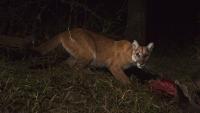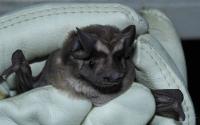Key NPCA Wildlife Program Campaigns
Since 1919, National Parks Conservation Association (NPCA) has advocated for America’s National Parks, including their beloved wildlife.
NPCA’s Protecting National Park Wildlife program advances goals that support species conservation as well as cross-cutting strategies to combat systemic threats like habitat destruction, unsustainable management, and the global biodiversity and climate change crises.
NPCA leverages the strong legal protections and public support of parks to ensure a better future for wildlife by: (1) CONNECTING park wildlife to healthy habitat outside park boundaries for their long-term survival; (2) PROTECTING park wildlife from mismanagement by state and federal agencies, including unsustainable hunting practices; and (3) RESTORING keystone species to national parks as well as their critical habitat outside park boundaries.

Katmai and Lake Clark National Parks: Brown Bear
Protecting the Bears of Alaska’s Bear Coast: Katmai and Lake Clark National Parks host the densest population of brown bears in the world. Fattening annually on salmon, these huge bears are the keystone predator in this remarkable ecosystem. NPCA is working with our partners to protect park bears from two proposed gold and copper mines in the region, offshore oil and gas spills, overhunting, and visitor impacts.

Gates of the Arctic National Preserve: Caribou
Defend Against Mismanagement: The Western Arctic Caribou Herd in Northwest Alaska which migrates annually in and around Gates of the Arctic National Park is a natural wonder of the world. Over 250,000 caribou travel 2,700 miles on one of longest annual land migrations on earth. Caribou are vital to these tundra and taiga ecosystems as well as to many of the people who call the region home. Learn more from our Story Map!

Alaska National Parks: Bears and Wolves
Defend Against Extreme Mismanagement: The State of Alaska has for many years sanctioned highly problematic hunting practices to reduce wildlife populations including bears and wolves. NPCA helped win a ban on these practices on NPS managed national preserves in Alaska, but the Trump administration reversed that ban in 2020. Today, NPCA is working with our partners to undue the 2020 regulation and protect park wildlife.

North Cascades National Park: Grizzly Bears
Restore Keystone Species: It’s estimated that few if any grizzly bears remain in the North Cascades National Park ecosystem in Washington. NPCA’s goal is for NPS and US Fish and Wildlife to relocate new bears to the ecosystem to restore the population. With our partners, we are actively encouraging the Biden administration to lead the way and make North Cascades grizzly recovery America’s next great wildlife recovery success story.

Rim of the Valley Expansion of the Santa Monica Mountains National Recreation Area: Mountain Lions
Safe Access to Healthy Habitat: The 150,000-acre Santa Monica Mountains National Recreation Area is simply not large enough to provide sufficient habitat for the mountain lions that reside there. Penned in by massive freeway systems and encroaching urban development, a recent study by the Park Service and University of California Los Angeles found that, without concerted conservation efforts, mountain lions could disappear from the park in 50 years, as inbreeding, vehicle collisions and other factors take their toll.

California Desert Park Wildlife: Tortoises and Desert Bighorn Sheep
Defend Against Mismanagement: NPCA is working with our community partners to protect at risk wildlife at Joshua Tree National Park, Mojave National Preserve, and the broader landscape on which park wildlife depend. We have won crucial protection for the endangered desert tortoise against loss of habitat from industrial energy development and are now working to ensure the Interior Department enforces those protections despite pressure from industry, and to extend similar protections to other parts of the region.

Yellowstone National Park: Pronghorn
Safe Access to Healthy Habitat: For over a decade, NPCA has led a collaborative community engagement and volunteer-driven program that brings together private landowners and public land managers to remove or alter fencing barriers so pronghorn can safely migrate throughout the Greater Yellowstone Ecosystem. To date, we have engaged over 1,100 volunteers and removed or altered 50 miles of fencing. This popular program has helped open historic winter range north and west of Yellowstone to pronghorn for the first time in decades resulting in improvements within the health of the herd.

Grand Teton and Yellowstone National Parks: Grizzly Bears
Defend Against Mismanagement: In 2017, the U.S. Fish and Wildlife Service removed grizzly bears in the Greater Yellowstone Ecosystem (GYE) from the Endangered Species List. The decision to remove protections failed to consider the best available science and could have set recovery of the population back by decades. In collaboration with our partners, NPCA successfully challenged the delisting in court. Today, NPCA is working with our partners and local community members to secure natural connectivity between the genetically isolated grizzlies of Yellowstone and Grand Teton to the population in and around Glacier National Park. This genetic connectivity is critical to the future health and recovery of Yellowstone’s iconic bears. See our Story Map!

Yellowstone National Park: Bison
Safe Access to Healthy Habitat: Every year when Yellowstone bison attempt to migrate beyond park borders to winter habitat, the herd is subject to aggressive management including being rounded up and shipped to slaughter. NPCA has been working for decades to ensure that bison are treated like other valued wildlife on the lands that surround Yellowstone. NPCA helped secure the first-ever agreement by the State of Montana to allow bison access to over 300,000 acres of public lands outside the park. We are now working with our tribal partners to ensure more disease-free Yellowstone bison are transferred to Native American cultural herds and other public lands within the National Park System rather than be shipped to slaughter.

Multiple National Parks: Colorado Wildlife Corridors
Safe Access to Healthy Habitat: From Rocky Mountain to Black Canyon of the Gunnison, national parks support hundreds of species in Colorado including elk, moose, black bear, bighorn sheep, mountain lion, bobcat, and the elusive lynx. The health of these species is directly linked to their ability to move across the landscape between protected spaces. For instance, the northeast corner of Rocky Mountain National Park alone ties into more than 100 separate elk migration routes. Fortunately, there is strong support in Colorado for wildlife corridors. In 2021, the Colorado Legislature unanimously passed the bipartisan Colorado Habitat Connectivity Senate Joint Resolution 21-021, a commitment to protect and enhance habitat connectivity. On the same day the governor issued a proclamation to officially acknowledge September 29, 2021 as “Wildlife Habitat and Connectivity Day.”

Big Thicket National Preserve: Red-cockaded Woodpecker
Restore Keystone Species: For more than a decade, NPCA has worked on-the-ground with community partners at Big Thicket to restore the native longleaf pine savannah. Through this work, volunteers have planted nearly 200,000 longleaf pine seedlings to help the park achieve their goal of restoring 30,000 acres of this critically important tree. Longleaf pine provides essential habitat for numerous threatened and endangered species such as the Red-cockaded Woodpecker and the Northern Bobwhite Quail.

Isle Royale National Park: Wolves
Restore Keystone Species: NPCA is working with partners to restore the wolf population on the island ecosystem at the remote Isle Royale National Park. Once abundant, by 2018 only two wolves remained, and the species had nearly disappeared from the island. Without wolves, the island’s moose population rapidly increased and was threatening the health of the park’s sensitive habitat.

Great Smoky Mountains National Park: Bear and Elk
Safe Access to Healthy Habitat: NPCA is engaged with a project to better understand how elk and black bears travel out of the park and into the Pigeon River Gorge and across the busy highway that divides the region, with the ultimate goal of establishing one or more wildlife overpasses.

Great Smoky Mountains National Park: Wildlife Movement
Safe Access to Healthy Habitat: To better understand and improve wildlife habitat connectivity in and around Great Smoky Mountains National Park, we are working in collaboration with scientists and partners to evaluate how species such as elk and black bear move from the park to adjacent protected lands.

National Parks Legal Defense: Park Wildlife
The Endangered Species Act (ESA) is our nation’s most effective law for protecting wildlife in danger of extinction. The Trump administration attempted to weaken the application of the ESA, which guides the recovery of over 600 threatened and endangered species that depend on habitat in national parks for their survival. NPCA with our partners filed multiple lawsuits challenging this weaking of the ESA. Learn more about how national parks and the ESA support each other – a win-win for parks and wildlife.

Park Wildlife Policy
Independent of the government and nonpartisan, NPCA engages decision-makers and park lovers including our more than 1.6 million members and supporters to secure a better future for park wildlife.

Big Cypress National Preserve + Everglades National Park: Florida Panther
Restore Keystone Species: It is estimated that only 120-230 federally protected Florida panthers remain in the wild. Threats from development-driven habitat loss, vehicle collisions, a recent mysterious disease, climate change, and oil exploration are jeopardizing the survival of this iconic species, Florida’s official state animal.

Everglades National Park and Big Cypress National Preserve: Florida Bonneted Bat
Restore Keystone Species: The endangered Florida Bonneted Bat is found nowhere else in the world outside of southern Florida. NPCA is actively leading work to protect the bonneted bat from the impacts of proposed oil development within Big Cypress National Preserve.

Multiple Park Units: Florida Wildlife Corridor
Safe Access to Healthy Habitat: The Florida Wildlife Corridor is a bold vision for preserving and connecting 17.9 million acres of conservation lands. The project identifies pathways of ecological connectivity that could be collaboratively conserved between existing and potentially new protected areas crisscrossing Florida, including Everglades National Park, all the way to the panhandle and Gulf Islands National Seashore, and the Okefenokee National Wildlife Refuge.

Acadia National Park: Atlantic Salmon
Defend Against Mismanagement: Acadia National Park is an archipelago of islands and unique coastal and terrestrial habitats where flora and fauna thrive. Surrounding Acadia is Frenchman Bay, which supports abundant marine life and coastal towns that are home to generations of mariners whose livelihoods depend on the health of the bay.